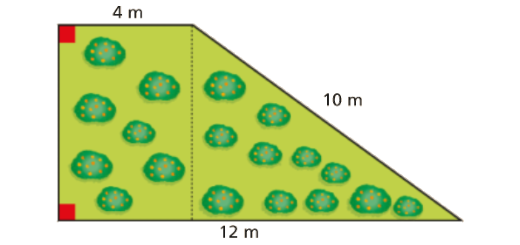Resolve as seguintes equações
Monómios e polinómios: Matematicamente Falando 8 - Pág. 145 Ex. 5
Resolve as seguintes equações.
| a) | \(4{x^2} – 49 = 0\) |
| b) | \(2{x^2} – 50 = 0\) |
| c) | \({\left( {x + 4} \right)^2} – 9 = 0\) |
| d) | \({\left( {x – 3} \right)^2} + 4 = 0\) |
| e) | \(3{x^2} + 4 = {x^2} + 4\) |
| f) | \(4{x^2} – {\left( {x + 1} \right)^2} = 0\) |
As equações estão resolvidas abaixo.
| a) | \(4{x^2} – 49 = 0\) | \[\begin{array}{*{20}{l}}{4{x^2} – 49 = 0}& \Leftrightarrow &{4{x^2} = 49}\\{}& \Leftrightarrow &{{x^2} = \frac{{49}}{4}}\\{}& \Leftrightarrow &{\begin{array}{*{20}{c}}{x = – \sqrt {\frac{{49}}{4}} }& \vee &{x = + \sqrt {\frac{{49}}{4}} }\end{array}}\\{}& \Leftrightarrow &{\begin{array}{*{20}{c}}{x = – \frac{7}{2}}& \vee &{x = \frac{7}{2}}\end{array}}\end{array}\] |
| b) | \(2{x^2} – 50 = 0\) | \[\begin{array}{*{20}{l}}{2{x^2} – 50 = 0}& \Leftrightarrow &{2{x^2} = 50}\\{}& \Leftrightarrow &{{x^2} = 25}\\{}& \Leftrightarrow &{\begin{array}{*{20}{c}}{x = – 5}& \vee &{x = 5}\end{array}}\end{array}\] |
| c) | \({\left( {x + 4} \right)^2} – 9 = 0\) | \[\begin{array}{*{20}{l}}{{{\left( {x + 4} \right)}^2} – 9 = 0}& \Leftrightarrow &{{{\left( {x + 4} \right)}^2} = 9}\\{}& \Leftrightarrow &{\begin{array}{*{20}{c}}{x + 4 = – 3}& \vee &{x + 4 = + 3}\end{array}}\\{}& \Leftrightarrow &{\begin{array}{*{20}{c}}{x = – 7}& \vee &{x = – 1}\end{array}}\end{array}\] |
| d) | \({\left( {x – 3} \right)^2} + 4 = 0\) | \[\begin{array}{*{20}{l}}{{{\left( {x – 3} \right)}^2} + 4 = 0}& \Leftrightarrow &{{{\left( {x – 3} \right)}^2} = – 4}\\{}& \Leftrightarrow &{x \in \emptyset }\end{array}\] |
| e) | \(3{x^2} + 4 = {x^2} + 4\) | \[\begin{array}{*{20}{l}}{3{x^2} + 4 = {x^2} + 4}& \Leftrightarrow &{2{x^2} = 0}\\{}& \Leftrightarrow &{{x^2} = 0}\\{}& \Leftrightarrow &{x = 0}\end{array}\] |
| f) | \(4{x^2} – {\left( {x + 1} \right)^2} = 0\) | \[\begin{array}{*{20}{l}}{4{x^2} – {{\left( {x + 1} \right)}^2} = 0}& \Leftrightarrow &{{{\left( {2x} \right)}^2} – {{\left( {x + 1} \right)}^2} = 0}\\{}& \Leftrightarrow &{\left( {2x + \left( {x + 1} \right)} \right)\left( {2x – \left( {x + 1} \right)} \right) = 0}\\{}& \Leftrightarrow &{\left( {3x + 1} \right)\left( {x – 1} \right) = 0}\\{}& \Leftrightarrow &{\begin{array}{*{20}{c}}{3x + 1 = 0}& \vee &{x – 1 = 0}\end{array}}\\{}& \Leftrightarrow &{\begin{array}{*{20}{c}}{x = – \frac{1}{3}}& \vee &{x = 1}\end{array}}\end{array}\] |
ALTERNATIVA PARA A RESOLUÇÃO DA EQUAÇÃO
Vamos resolver seguidamente as três primeiras equações utilizando um processo diferente.
\[\begin{array}{*{20}{l}}{4{x^2} – 49 = 0}& \Leftrightarrow &{\left( {2x + 7} \right)\left( {2x – 7} \right) = 0}\\{}& \Leftrightarrow &{\begin{array}{*{20}{c}}{2x + 7 = 0}& \vee &{2x – 7 = 0}\end{array}}\\{}& \Leftrightarrow &{\begin{array}{*{20}{c}}{x = – \frac{7}{2}}& \vee &{x = \frac{7}{2}}\end{array}}\end{array}\]
\[\begin{array}{*{20}{l}}{2{x^2} – 50 = 0}& \Leftrightarrow &{{x^2} – 25 = 0}\\{}& \Leftrightarrow &{\left( {x + 5} \right)\left( {x – 5} \right) = 0}\\{}& \Leftrightarrow &{\begin{array}{*{20}{c}}{x + 5 = 0}& \vee &{x – 5 = 0}\end{array}}\\{}& \Leftrightarrow &{\begin{array}{*{20}{c}}{x = – 5}& \vee &{x = 5}\end{array}}\end{array}\]
\[\begin{array}{*{20}{l}}{{{\left( {x + 4} \right)}^2} – 9 = 0}& \Leftrightarrow &{{{\left( {x + 4} \right)}^2} – {3^2} = 0}\\{}& \Leftrightarrow &{\left( {\left( {x + 4} \right) + 3} \right)\left( {\left( {x + 4} \right) – 3} \right) = 0}\\{}& \Leftrightarrow &{\left( {x + 7} \right)\left( {x + 1} \right) = 0}\\{}& \Leftrightarrow &{\begin{array}{*{20}{c}}{x + 7 = 0}& \vee &{x + 1 = 0}\end{array}}\\{}& \Leftrightarrow &{\begin{array}{*{20}{c}}{x = – 7}& \vee &{x = – 1}\end{array}}\end{array}\]
Em que consistiu o processo diferente usado na resolução destas três equações?


















